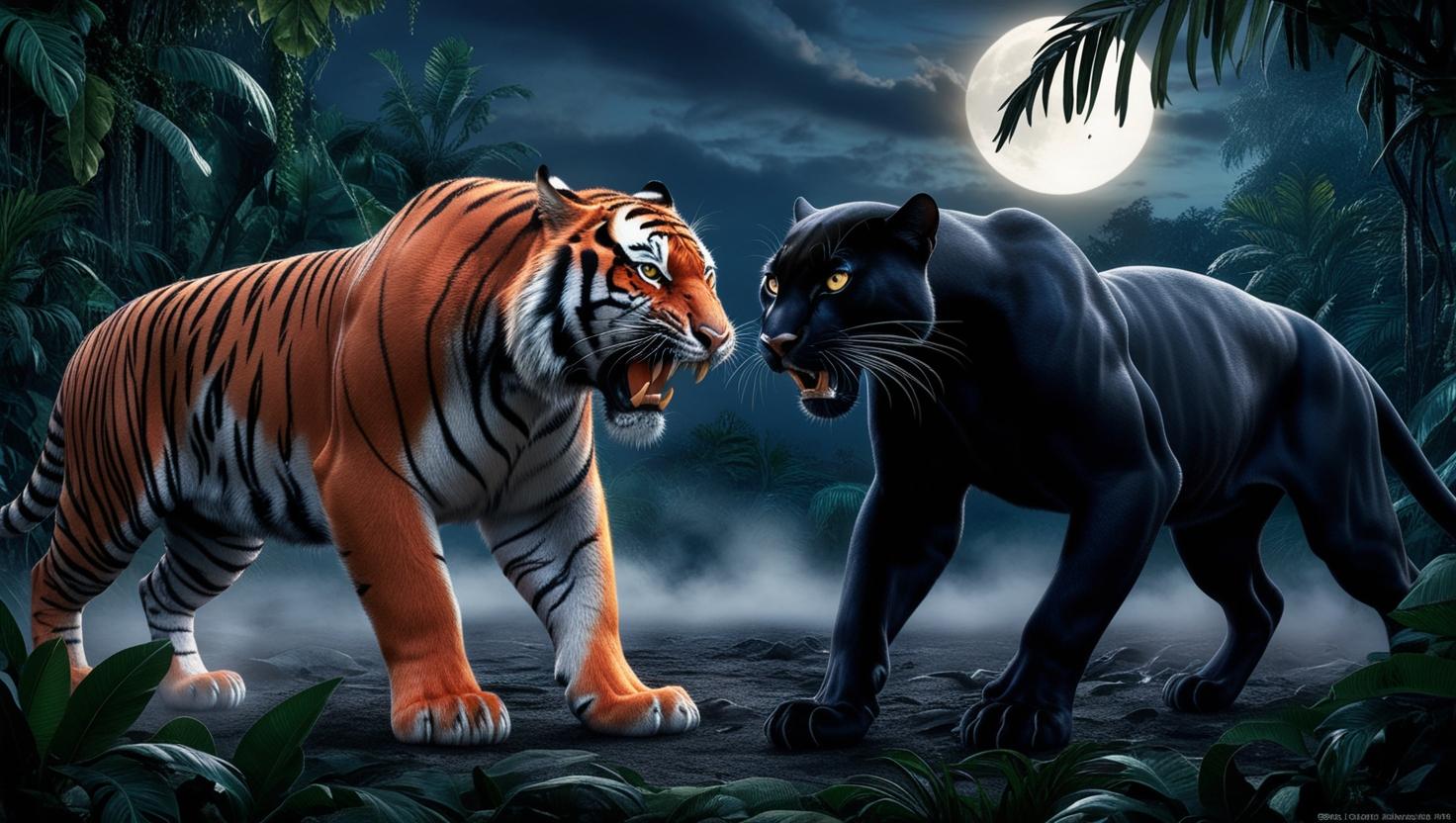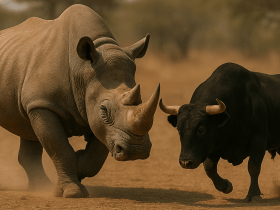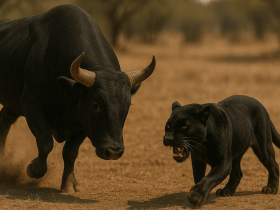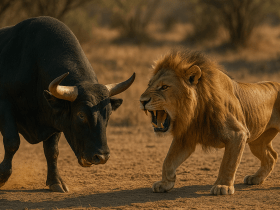Here I have bought you a complete list of specifications under the topic of Tiger vs Black Panther . Hope you will enjoy!
Table of Contents
Toggle1. Body Specifications
| Subtopic | Tiger | Black Panther | Winner |
|---|---|---|---|
| Height (at shoulder) | 0.9–1.1 meters | 0.6–0.9 meters | Tiger |
| Length (head to tail) | 2.5–3.9 meters | 1.8–2.5 meters | Tiger |
| Weight | 90–310 kg | 36–96 kg | Tiger |
| Body Shape | Robust, muscular, elongated body | Sleek, compact, agile | Tie |
| Bone Density | Higher bone density for strength | Lower bone density for agility | Tiger |
| Muscle Mass | 60–70% of body weight | 50–60% of body weight | Tiger |
| Tail Length | 0.6–1.1 meters | 0.6–1 meter | Tie |
| Paw Size | Large paws for gripping prey | Smaller paws for climbing | Tiger |
| Neck Strength | Strong for subduing prey | Less robust neck muscles | Tiger |
| Overall Size | Larger and heavier | Smaller and lighter | Tiger |
2. Coat and Coloration – Tiger vs Black Panther
| Subtopic | Tiger | Black Panther | Winner |
|---|---|---|---|
| Base Color | Orange with white underbelly | Black (melanistic variant) | Tie |
| Pattern | Vertical stripes for camouflage | Rosette patterns (visible under light) | Tie |
| Melanin Levels | Normal melanin distribution | High melanin levels (melanism) | Black Panther |
| Coat Thickness | Thicker for colder climates | Thinner for warmer climates | Tiger |
| Coat Function | Camouflage in forests and grasslands | Camouflage in dense forests | Tie |
| Reflectivity | Low reflectivity | High reflectivity in sunlight | Black Panther |
| Cub Coloration | Striped from birth | Spotted (if not melanistic) | Tie |
| Seasonal Changes | Minimal | Minimal | Tie |
| Unique Markings | Unique stripe patterns | Unique rosette patterns | Tie |
| Thermoregulation | Insulates in cold climates | Absorbs heat in warm climates | Tie |
3. Habitat and Range
| Subtopic | Tiger | Black Panther | Winner |
|---|---|---|---|
| Geographic Range | Asia (India, Siberia, Sumatra) | Africa, Asia, Americas | Black Panther |
| Habitat Type | Forests, grasslands, mangroves | Rainforests, savannas, mountains | Tie |
| Adaptability | Highly adaptable | Prefers dense forests | Tiger |
| Climate Preference | Cold to tropical | Warm to tropical | Tie |
| Territory Size | 20–100 km² | 10–50 km² | Tiger |
| Elevation Range | Up to 3,000 meters | Up to 4,500 meters | Black Panther |
| Human Proximity | Avoids human settlements | Can live near humans | Black Panther |
| Migration Patterns | Non-migratory | Non-migratory | Tie |
| Endangered Habitats | Losing habitats | Losing habitats | Tie |
| Range Overlap | Limited | Overlaps with tigers in some regions | Tie |
4. Diet and Hunting – Tiger vs Black Panther
| Subtopic | Tiger | Black Panther | Winner |
|---|---|---|---|
| Prey Type | Large ungulates (deer, boar) | Medium-sized mammals (monkeys, antelope) | Tiger |
| Hunting Success Rate | 10–20% | 20–30% | Black Panther |
| Daily Caloric Intake | 5,000–7,000 kcal | 1,500–3,000 kcal | Tiger |
| Hunting Techniques | Ambush and overpower | Stealth and climbing | Tie |
| Prey Size | Up to 500 kg | Up to 100 kg | Tiger |
| Scavenging Behavior | Rarely scavenges | Occasionally scavenges | Black Panther |
| Hunting Time | Nocturnal and crepuscular | Nocturnal | Tie |
| Kill Frequency | 1 large kill per week | 1–2 kills per week | Black Panther |
| Food Storage | Caches prey | Rarely caches prey | Tiger |
| Competition | Competes with leopards & dholes | Competes with tigers & lions | Tie |
5. Strength and Bite Force
| Subtopic | Tiger | Black Panther | Winner |
|---|---|---|---|
| Bite Force (PSI) | 1,050 PSI | 600–700 PSI | Tiger |
| Claw Strength | Retractable, sharp claws | Retractable, sharp claws | Tie |
| Lifting Capacity | Can lift 2x body weight | Can lift 1.5x body weight | Tiger |
| Jaw Muscles | More powerful | Less powerful | Tiger |
| Neck Bite Precision | Targets spine and throat | Targets throat | Tiger |
| Limb Strength | Stronger forelimbs | Stronger hind limbs | Tie |
| Bone Crushing Ability | Can crush large bones | Can crush smaller bones | Tiger |
| Swatting Force | 10,000 lbs of force | 5,000 lbs of force | Tiger |
| Grip Strength | Stronger grip for large prey | Strong grip for climbing | Tiger |
| Overall Strength | Stronger in all aspects | Strong but less powerful | Tiger |
6. Speed and Agility
| Subtopic | Tiger | Black Panther | Winner |
|---|---|---|---|
| Top Speed | 49–65 km/h | 58–60 km/h | Black Panther |
| Acceleration | 0–60 km/h in 4 seconds | 0–60 km/h in 3 seconds | Black Panther |
| Agility in Trees | Can climb but less agile | Extremely agile in trees | Black Panther |
| Swimming Ability | Excellent swimmer | Good swimmer | Tiger |
| Stamina | High stamina for long chases | Moderate stamina | Tiger |
| Jumping Height | Can jump 5 meters vertically | Can jump 3 meters vertically | Tiger |
| Jumping Distance | Can jump 9 meters horizontally | Can jump 6 meters horizontally | Tiger |
| Climbing Speed | Slower climber | Faster climber | Black Panther |
| Maneuverability | Less maneuverable | Highly maneuverable | Black Panther |
| Overall Agility | Strong but less agile | Highly agile | Black Panther |
7. Senses – Tiger vs Black Panther
| Subtopic | Tiger | Black Panther | Winner |
|---|---|---|---|
| Vision Acuity | Excellent night vision | Superior night vision | Black Panther |
| Hearing Range | Can hear up to 60 kHz | Can hear up to 65 kHz | Black Panther |
| Olfactory Capabilities | Strong sense of smell | Stronger sense of smell | Black Panther |
| Depth Perception | Excellent | Excellent | Tie |
| Color Vision | Limited color vision | Limited color vision | Tie |
| Motion Detection | Highly sensitive | Highly sensitive | Tie |
| Low Light Vision | Excellent | Superior | Black Panther |
| Sensory Whiskers | Highly sensitive | Highly sensitive | Tie |
| Auditory Localization | Precise | More precise | Black Panther |
| Overall Senses | Strong senses | Stronger senses | Black Panther |
8. Reproduction and Lifespan
| Subtopic | Tiger | Black Panther | Winner |
|---|---|---|---|
| Gestation Period | 93–112 days | 90–105 days | Tie |
| Litter Size | 2–4 cubs | 2–3 cubs | Tiger |
| Cub Mortality Rate | 30–40% | 40–50% | Tiger |
| Sexual Maturity Age | 3–4 years | 2–3 years | Black Panther |
| Lifespan (Wild) | 10–15 years | 12–15 years | Black Panther |
| Lifespan (Captivity) | 16–20 years | 20–23 years | Black Panther |
| Parental Care | Mother raises cubs alone | Mother raises cubs alone | Tie |
| Weaning Age | 6–8 months | 3–4 months | Black Panther |
| Interbirth Interval | 2–3 years | 1–2 years | Black Panther |
| Reproductive Success | Lower due to habitat loss | Higher due to adaptability | Black Panther |
9. Social Behavior
| Subtopic | Tiger | Black Panther | Winner |
|---|---|---|---|
| Social Structure | Solitary | Solitary | Tie |
| Territorial Range | 20–100 km² | 10–50 km² | Tiger |
| Communication Methods | Roars, growls, scent marking | Growls, hisses, scent marking | Tie |
| Aggression Levels | Highly aggressive | Less aggressive | Tiger |
| Mating Behavior | Polygamous | Polygamous | Tie |
| Cub Interaction | Mother-cub bond only | Mother-cub bond only | Tie |
| Territorial Marking | Scent marking and scratching | Scent marking and scratching | Tie |
| Conflict Resolution | Physical fights | Avoidance and posturing | Black Panther |
| Group Hunting | Never | Rarely | Tie |
| Overall Sociability | Less social | Slightly more social | Black Panther |
10. Conservation Status
| Subtopic | Tiger | Black Panther | Winner |
|---|---|---|---|
| IUCN Status | Endangered | Vulnerable (leopard/jaguar) | Black Panther |
| Population Trends | Declining | Stable/Declining (varies by region) | Black Panther |
| Threats | Poaching, habitat loss | Poaching, habitat loss | Tie |
| Conservation Efforts | Strict anti-poaching laws | Protected areas and anti-poaching | Tie |
| Wild Population | ~3,900 individuals | ~500,000 (leopards/jaguars) | Black Panther |
| Captive Population | ~7,000 individuals | ~10,000 individuals | Black Panther |
| Genetic Diversity | Low due to fragmented populations | Higher due to larger populations | Black Panther |
| Reintroduction Success | Limited success | Moderate success | Black Panther |
| Public Awareness | High | Moderate | Tiger |
| Future Outlook | Critical | Stable but concerning | Black Panther |
Conclusion – Tiger vs Black panther
In the tiger vs black panther debate, each animal excels in different areas. Tigers dominate in size, strength, and raw power, while black panthers showcase superior agility, senses, and adaptability. Both face significant conservation threats, making their protection a global priority.
References
IUCN Red List – Conservation status of elephants and rhinos.
www.iucnredlist.orgNational Geographic – Insights on elephant and rhino behavior, habitat, and diet.
www.nationalgeographic.comSmithsonian’s National Zoo & Conservation Biology Institute – Research on elephant and rhino conservation efforts.
https://nationalzoo.si.eduWorld Wildlife Fund (WWF) – Population trends, threats, and conservation strategies for elephants and rhinos.
www.worldwildlife.orgJournal of Mammalogy – Scientific studies on elephant and rhino physiology, ecology, and reproduction.
https://academic.oup.com/jmammal
Read More – Tiger Vs Jaguar vs Lions – Best Full Technical Comparison






Leave a Reply